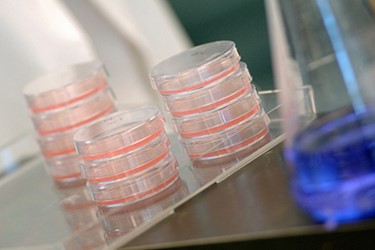Purification Of An Acidic Enzyme Using Ceramic Hydroxyapatite Chromatography
By Louisa Vang and Xuemei He, Bio-Rad Laboratories

Crystalline hydroxyapatite is a naturally occurring mixed-mode chromatography media. This inorganic material has a chemical composition of (Ca5(PO4)3OH)2 with hydroxyl groups, calcium doublets, and phosphate triplets arranged in a repeating geometric pattern. The phosphoryl groups (P sites) interact with positively charged amino residues of protein molecules electrostatically, while the calcium ions in the crystal lattice (C sites) form a chelation complex with the carboxylic side chains of aspartyl and glutamyl residues (Figure 1). These types of interactions operate synergistically or individually, offering unique selectivity for bioseparation. The ceramic form of hydroxyapaptite, CHT, is a spherical, macroporous, and hydrodynamically stable chromatography media. It has been widely employed for the general preparation of biomolecules as well as the commercial production of biopharmaceuticals.
Chromatography with CHT Media is typically operated in the pH range of 6.5–7.5. At these pH levels, acidic proteins, namely those with a pI lower than 7, are negatively charged. They are likely repelled by the P sites on CHT, while facing competition for the C sites from acidic impurities (such as the nucleic acids and endotoxins in feedstock). The use of buffers containing inorganic phosphate for chromatography may further compromise the binding of acidic proteins by CHT. In the present study, we attempted to use CHT for the polish purification of an acidic enzyme, CDP-Dglucose 4,6-dehydratase (Eod) (Thorson et al. 1994). The pI of this enzyme has been estimated as 6 on the basis of its polypeptide sequence (Thorson et al. 1994, He et al. 1996, Vogan et al. 2002). The recombinant enzyme was overproduced in E. coli while the crude cell extract contained enormous amounts of endotoxins and nucleic acids that are strong contenders for the C sites on CHT. Using conditions identified in the design of experiment (DOE) screening, we were able to perform scale-up purification of this enzyme on CHT columns to achieve efficient removal of a variety of acidic impurities.
Get unlimited access to:
Enter your credentials below to log in. Not yet a member of Bioprocess Online? Subscribe today.
